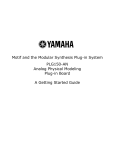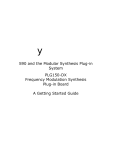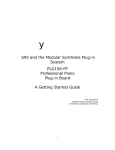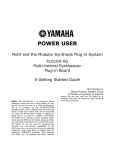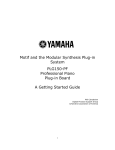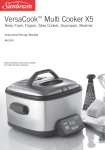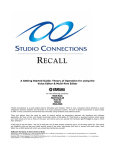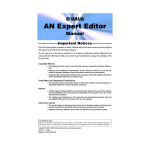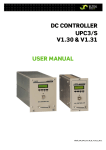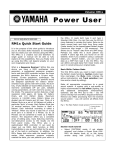Download Yamaha MU2000 Owner`s manual
Transcript
y S90 and the Modular Synthesis Plug-in System PLG150-AN Analog Physical Modeling Plug-in Board A Getting Started Guide yS90 & PLG150-AN The VOICE EDITOR for S90 will let you program USER Bank Voices for the S90. That is, AWM2 Normal User Voice, Drum User Kits and PLG150 Series User Plug-in Voices. Then why do you need the AN EXPERT EDITOR? Because the EXPERT EDITOR will let you edit the analog Voice Element itself. The S90 editor will let you integrate a finished AN Element with the S90. The AN EXPERT EDITOR will let program the analog engine itself. Many parameters affecting the AN board are available from the S90 front panel and via the Voice Editor for S90, however, the fundamental and complete set of edit parameters are available only via the AN EXPERT EDITOR. It would be impossible to include in the S90 architecture all of the parameters for each of the possible plug-in boards available. Several of the PLG150 Series boards are entirely different technologies: AN is a physical model of an analog synthesizer – there are no samples in this technology. The DX is a Frequency Modulation (FM) synth equivalent to a DX7 – there are no samples in this technology. The VL is a physical model of an acoustic blown pipe/bowed string instrument – there are no samples in this technology. The PF, DR and PC boards are sample playback (like the S90). The parameters for these technologies are each a whole synthesizer by itself (and each has been). If you want to program from scratch, the AN Expert Editor will allow in depth editing. If you are just a tweaker – one who likes to fiddle with existing sounds – each board will give you plenty of data to work with and plenty of parameters to play with, as well. If, however, you do enjoy making sounds from scratch, you will love the way the S90-PLG150-computer system works. It will take some getting used to but is very powerful. Ultimately, you will be able to make custom sounds via the computer editor’s graphic interface and save the data to SmartMedia card or SCSI drive and restore them when you are at the gig (the computer remains safe at home where it belongs). You will not be editing from scratch while on stage – you put the voice in the S90 in a form that allows you to perform them via the available controllers. The PLG150-AN will add its own 5-notes of polyphony to the modular system. PLG150-AN Analog Physical Model The PLG150-AN is a single part plug-in module – capable of reproducing one virtual analog Voice at a time – capable of contributing one Part to the host product. It is like a separate synthesizer that you add to the S90 or other Modular Synthesis Plug-in System product. The board is a separate synthesizer but it must use the hardware of the host product to be heard. There are several levels of accessing sounds on the PLG150-AN when it is inserted into the S90. To better understand this, let’s take it a step at a time. The PLG150-AN board is a part of the Yamaha PLG150 series. These synth series boards add a single part to the host product. They are not multi-timbral. The AN board has 256 preset voices and RAM locations for 128 user board voices. The Presets are divided into 2 banks of 128 each. The user bank for your own custom board voices is available via bulk dumps. The 128 user board Voices can be created and/or loaded in with computer software, AN Expert Editor, and they exist in a volatile RAM bank on the board. They can also be saved in a special bulk type file to SmartMedia card. The AN Expert Editor will allow you to create your own analog voices from scratch. (More on the AN Expert Editor and custom ‘from-scratch’ analog User Voices in the next installment). First, lets understand how to access, edit, save and load sounds made from the supplied preset data. An important part of the concept to the plug-in boards is that although the PLG150-AN is an analog synth, it does not have wheels, or knobs, or a screen, or keys, it has a distortion but no other effects…all of that must come from the host product, the S90. The AN board has some 256 preset sounds on it, but until you integrate them with the S90 parameters they are what we call a BOARD Voice. Once you have routed them through the S90 effects and assigned S90 controllers etc., they become what we call a PLUG-IN Voice. When the PLG150-AN is properly installed in a S90 and you power up, the S90 does a system check and scans the PLG board slots. When it finds a PLG150-AN board it will automatically load 64 finished PLUG-IN Voices (PLGPRE1). With each of the PLG150 series boards you will also find 64 blank PLUG-IN Voice locations for you to store your tweaks or customized versions of the sounds (PLGUSR). You will find that you can use two editors when you have both a PLG150-AN and a S90. Summary: The PLG150-AN is part of a ‘modular’ system. It is analogous to adding a hardware synthesizer to your host product, the S90. The S90 will address certain performance-oriented parameters on the board via offset values. The Voices on the board are programmed via a computer Voice Editors (AN Expert Editor and the 2 Voice Editor for S90) which can send Voice setups to the S90. The idea is to do “in depth” editing of the voice in the computer editor (AN Expert Editor), then integrate with the controllers and effects of the S90 (Voice Editor for S90). The PLG150-AN board is like adding a separate component to your host product. As you will see there are some sounds that come directly from the board (Board Voices) and others that you will make that integrate the Board Voices with the host products routing, controllers and effects (called Plug-In Voices). Think of the Board Voices as the raw data you build the Plug-In Voices out of. The PLG150 series are synth boards that are capable of playing back a single Part within the host product. When you install a PLG150-AN into the S90 you will be able to create 64 PLUG-IN USER (PLGUSR) Voices using any of the board voice data plus you are given 64 all ready made Preset Plug-In (PLGPRE1) Voices that have been made using the S90 routing and effects. In a multi-timbral setup (MIXING) the S90 will have 16 AWM2 Sample playback sounds on Parts 116. You can replace or layer/split a PLG150 voice with an AWM2 Voice in one of the 16 Parts. Or if you are using the USB(MIDI) connection and an external sequencer you can address the S90 on one Port and the PLG150 boards on another Port. Please read this guide carefully – as the PLG150 boards are quite unique. Even if you have owned other manufacturer’s products that take plug in boards, the Yamaha Modular Synthesis Plug-in System is a unique arrangement – these are not just new sounds, they are different technologies! PLG150-AN can give you a maximum of 10 notes of analog polyphony in Expand poly mode. A third PLG150 can give you 15 notes total. Because the System is modular, this polyphony does not take away from the 64-note polyphony of the mothership host (S30 / S80 / CS6x / CS6R / S906-7-8)- Nor does it contribute to a pool of notes – they are completely separate. You, of course, can use multiple boards as individuals, thus increasing how many Parts you for which you will have analog sounds available. Checking Installation PLGUSR – 64 blank locations for your first creations integrated with the S90 controller / effect parameters. Banks of sounds Sixty-four Plug-in Voices are pre-loaded into the S90 when the PLG150-AN board is detected on power up – you can select between ‘Banks’ from the main [PLG] Voice screen by pressing [F2] Bank, then use [INC/YES] and [DEC/NO] buttons to change banks. There are two Plug IN Voice banks – one for the 64 pre-loaded sounds and one for you the user. PLGPRE1 – a bank of 64 already made (preset) Plug In Voices loaded in at power up. Check to make sure your board or boards are properly installed. The wire with one Orange connector is slot 1, the wire with one yellow connector is slot 2 and the single Green connector is slot 3. A PLG150-series board can occupy any slot.1 The boards should always be installed with the S90 off – the boot up routine will check the plug in slots and automatically load 64 Preset sounds for the detected board. (The VL board is the exception. It has actually 3 banks of 64 – one for Aftertouch, one for velocity play and one for breath control). Here’s how to verify your board: Additionally, PLG150 series boards can have many ‘raw’ Board Voice banks on them (the PLG150-AN has 2 banks of 128 preset Board Voices and one bank of 128 user locations). Those Banks are named 036/000, 036/001 and 036/002, respectively. The 128 user RAM locations in 036/002 are for your ‘from scratch’ analog sounds created with the AN Editor program. (More on this later) Play through the PLGPRE1 bank (Plug-in Voices). Press [PLG1], [PLG2] or [PLG3] (depending on which slot you have placed you’re an board) and select sound A01, the sound called ‘Killer’. There are 64 Plug-in Voices (A01-D16). The screen should read “Px—P:” in the upper left corner; where ‘Px’ is the Plug-in slot number and On the S90: Press [UTILITY]/[F6] PLG/ SF1 Status to check the status screen: The “Expand” parameter will be active only when you have 2 or more PLG150 series boards of the same type installed and polyphony expansion is possible. A second 1 HINT: Find a consistent slot layout for your boards and stick with it. When making bulk files that reload your custom sounds, it matters which slot the board is found in. 3 ‘P’ is for Preset, for example, a PLG150-AN in slot three would read “P3—P: 001 Killer” What is a Plug-in Voice and what is a Board Voice? The Plug-in Voices are found from the front panel of the host synth under the [PLG1], [PLG2] and [PLG3] buttons. The S90 will load 64 Plug-In PRESET (PLGPRE1) Voices pointing at elements on the PLG150-AN board. What that means is that out of the 256 sounds provided by the AN board, 64 have already been integrated with S90 effects and controller routing. PLUG IN Voices use the mothership’s parameters, routing and effects but call on a synth element data resident on the board. The PLGUSR bank is blank and awaits you to create your own variations. The element voice data on the board are called the Board Voices. Instead of using ROM samples from the host, the PLG-AN Voices point to data that is resident on the PLG board. The Voice data contained on the PLG150-AN is not based on sampled data like the internal voices. The sounds of the AN board are generated mathematically through complex physical modeling technology. Physical Modeling is a technique that uses computer computations to render a result from data that is input. Physical Modeling is used in such things as architecture, weather prediction, flight simulation and other ‘virtual reality’ devices. In this case, modeling is used to construct a mathematical representation of the voltage controlled analog synthesizer. With this model it is possible to recreate analog synthesis, virtually. These calculations take place in the CPU on the plug-in board. When you explore the AN Expert Editor be sure to check out the routing overlays so that you can see how signal flows from VCO-VCF to VCA etc. Plug-In Voices are Board Voices that have been integrated into the mothership’s setup and are stored in either bank [PLG1], [PLG2] or [PLG3] –depending on where you’re an board is located. *Other banks (are for XG extension) 084/000, 084/064~084/081, 084/096~084/107, 100/000, and 100/064~100/076 are PLG extensions for use in XG/GM systems *These are basically the preset board Voices arranged into various banks for use non-Modular Synthesis Plugin System products that can also access sounds on the PLG150 series boards. They are the same 256 sounds just rearranged for GM/XG category use. You can ignore these. For example, all synth bass sounds, as per GM, will have a Program Change of 39 and 40 – but XG offers you many substitution or variations on the Synth Bass. To listen to the 256 ‘preset’ Board Voices provided, from Voice mode: • • • • Press [F2] Memory from the main Voice screen. Use [DEC/NO] and [INC/YES] to switch between AN Plug-in and Board banks. Select the Board Voice bank you wish to explore: the Board Voice preset banks are: 036/000 = preset1; 036/001 = preset2. Notice that the upper left corner of the main Voice screen will read P1-B for slot 1, P2-B for slot 2 or P3-B for slot 3. The ‘B’ denotes a board voice, not yet integrated with the S90 host parameters (effects, etc.). Raw data. The banks of Board Voices are arranged according to their Bank Select (MSB/LSB) and Program Change (1-128) numbers. If this is your first experience using MIDI MSB/LSB bank select commands it may seem a bit confusing at first but you will get used to it. MIDI uses two Control Change messages (cc) to allow for some 16,384 possible banks – each with up to 128 locations (see below). The two ‘B” or Board preset banks (named 036/000 and 036/001) each contains 128 Voices each (A01-H16). The user RAM bank (036/002) is volatile – meaning Voices here need to be backed up before powering down. This is the bank where the AN Expert Editor software will deposit sounds. You can store your totally original creations here and back them up The AN board has several banks of sounds as follows: The numbers represent MSB/LSB for bank select – (MSB and LSB Bank Select numbers are used to facilitate remote changes from a device like a sequencer. More on that later). PLGUSR = 64 blank locations (Saved in ALL DATA File) PLGPRE1 bank = 64 locations with Preset PLUG IN VOICES loaded on detection of the PLG150AN; (Loaded automatically on power up) 036/000 = 128 preset1 Board Voices 036/001 = 128 preset2 Board Voices 036/002 = 128 user RAM Board Voices 4 • in a bulk type file. When the unit is powered down these voices will disappear. Each time you power up, this bank reverts to 128 voices collected from the other presets that act as default placeholders. The placeholders are not important and are to be written over! Voice data you create can be saved to SmartMedia card and stored so that they are retrieved automatically on power up. See PLG150-AN Owner’s Manual pages 38-45 for Voice Lists. See the S90 Owner’s Manual for instruction on creating Auto-load files for user bulk data. • • • • • • Note on Bank Select: MIDI provides for 128 program changes – so when a product has more than 128 sounds, the sounds can be organized in multiple banks of 128 or less programs. When you load in or create new AN voices via the computer editors you will be using the user RAM area, bank 036/002, writing over the default ‘placeholder’ voice set. Your edits will be in volatile RAM so you will have to save your work before exiting. Like working with a computer word processor, you are working in RAM and you must save your work or document before exiting the program. You can save your work via the editor or to SmartMedia card via the synth. Don’t waste time looking through the default 036/002 voices or the various XG extension banks. All those voices are just repeats of the 256 presets that are contained in the 036/000 and 036/001 banks. [The XG banks are for use with the XG/GM ‘voice substitution’ system (modules like Yamaha MU128, MU1000/MU2000) interface. If you are using the PLG150 board in a S90, S80/S30, CS6x/R, you can ignore these additional bank configurations.] • • • How to create a finished S90 Plug-in Voice from a PLG150-AN Board Voice. Press [JOB] and select the Initialize [F1] function. Initialize the current Voice position. Press [ENTER], then [INC/YES] to execute. Press [EDIT] Select the OSC page – Touch track button [1] to select element level edits. Press [F1] OSC / [SF1] Wave Using the data wheel select Bank 036/001; Select Program Number = 001[Cracker] 2. Explore the Element parameter pages; Use the [F] keys to navigate the different screens. Use button [F4] to select the ‘Native’ (parameters) page. Native Parameters refers to parameters that address the data on the PLG150-AN board. You are offsetting data that originates on the board. Use the cursor arrows to navigate the pages. The concept of OFFSET is simple. If the originally programmed data for a parameter was set to 100, for example, and you set that Native Parameter to a value of –25, then the parameter will be set to 75. You are simply adding or subtracting values from the preset data. Experiment with making edits – both on the Element level and the Common level. On the Element level check the [F] keys for parameters. You have a dedicated modeled Distortion and EQ. You can add S90 level parameters on the COMMON level. Push the [COMMON] button to edit Common (S90) level parameters. Practice navigating the edit area. Try adding some S90 EFFECTS. Press [F6] Effects/ [SF1] Connect.3 There are the Dual Insertion Effects available on the Common level. INS1 has 25 effect algorithms and the INS2 has 104. Also available are the KNOB CONTROL FUNCTION parameters. You have the 4 knobs that can be selected: • Let’s use “Cracker”, a Board Voice bass sound, to learn something about how the AN synth works using on board (S90) parameters. Don’t be afraid to explore when you are paging through the EDIT mode. • From [VOICE] mode select the [PLG] bank that contains your PLG150-AN, [PLG1], [PLG2] or [PLG3] Top row: knobs for Pan, Reverb, Chorus, Tempo (when appropriate) 2 You may notice that response time to selection is slower than the internal AWM2 sounds. This is the twoway editing communication between the Host and the Board – it is quite normal. When each configuration of the model is recalled all of its data is communicated. 3 Element level (Program button [1]) and Common level ([COMMON] button) – are available. S90 effects are Common level. 5 • • • • • • • level. You can set the poly-mono-mono/legato parameter in the AN Expert Editor. You may find some parameters make no difference when you move the knob – this can happen when the original Voice data does not use that parameter in the current configuration or it is already at maximum or minimum and you cannot offset it further. To fully view the entire list of parameters available you must open the AN Expert Editor software. The host product will give access to a smaller set (see below) of the full list (see editing software). Second row: Cutoff, Resonance, Attack and Release. Third row: ASA (assignable knob A) is set to control envelope initial Decay and ASB (assignable knob B) is set to control envelope Sustain. AS1 and AS2 are assignable per Voice in the Voice Edit - Common level CONTROL SETS, [F4] CtlSet. The bottom row: gain controls for 4-bands of EQ (storable per Voice)! When you press [STORE] your work will be saved to one of the 64 PLGUSR locations and become a proper Plug-In Voice. They will go to the “Px—U” PLGUSR bank- ‘Px’ for your Plug-in slot, ‘U’ is User. You have made a complete PLUG IN VOICE from Board Voice data. When you save your first data to the PLGUSR Bank your Voice will be there alone. Don’t panic if you press a program button and all the other places in that bank say “---:------“. Simply press [F2] Bank and select a bank. When you attempt to store you are automatically taken to the USER bank, of course. When you save an ALL DATA file type the PLG bank Voice data will be saved to SmartMedia card. However, as we will see, if you have made any custom user Board Voices (those voices made from scratch via the editor in bank 036/002) will need to be saved separately in a bulk type file (.w2b). As long as your S90 Plug-in Voices point to preset Board Voices your Voices will be backed up in a regular ALL data file. It is when you have used the 036/002 user bank to create brand new AN sounds that you must also save a bulk file. The PLG150-AN has its own clock that controls the working of the its arpeggiator and step sequencer. This is independent of the arpeggiator and sequencer of the host unit. (By the way, to sync the AN clock to the S90 host, simply set the Native parameter TEMPO on the board to ‘MIDI’ clock. This is done on a per Voice basis). Explanation: The Native Parameters are parameters that are native to the technology on the board in question. Each PLG150 series board represents an entirely different technology. These are available from the front panel of the S90 and for the AN board include: Unison Switch Arp/SEQ Switch Tempo LFO2 Speed Sync Pitch FM Depth VCO Detune VCO1 Edge (harmonic content of source wave) VCO1 Pulse Width VCO1 Pulse Width Modulation Depth VCO2 Edge (harmonic content of source wave) VCO2 Pulse Width VCO2 Pulse Width Modulation Depth Mix VCO1 Mix VCO2 Mix Ring Modulation Mix Noise Mix Feedback VCF Filter Modulation Depth Filter Envelope Generator Depth Filter Envelope Generator Attack Filter Envelope Generator Decay Filter Envelope Generator Sustain Filter Envelope Generator Release VCA Amplitude Modulation Depth Amplitude Envelope Generator Attack Amplitude Envelope Generator Decay Amplitude Envelope Generator Sustain Amplitude Envelope Generator Release Distortion Drive Assignable Control Parameter Assignable Control Depth This makes an impressive, but incomplete, list of AN parameters (there are many, many more). The others can be reached only via the AN Expert Editor software. You will notice that most of the parameters in the host offer you an offset value +/- 00, or a choice that sets the value to “on”, “off” or default as programmed in the original Voice (you’ll see “vce”). If you see “***” – this denotes the parameter is not available, at all. These offsets are offset from the original programming value. To get at the real AN parameters for each setting, use the AN Expert Summary: We learned a few things. You may have noticed that changing certain S90 parameters make little or no difference in the sound on the PLG board. The COMMON: POLY/MONO mode switch is overridden by the poly-mono-legato setting of the AN board Voice itself (set within the editor). Polyphony issues of the PLG150-AN board are handled at the board 6 Editor. For example, if you want to change the source waveform or change the routing of the oscillators within the model. This kind of editing is done on the computer. The parameters that you manipulate form the host product are those that are performance oriented. Here is the thinking: You hook up to the computer when you are ready to “sound design”. Put the Voice in a condition that is performance ready…download the results to your keyboard …back the data up on a SmartMedia card…leave the computer home and go rock-out at the gig. voice data in a slot not containing the right board will cause a TYPE MISMATCH error or you will simply not hear your sound (even with the name showing). The board for the voice data must be in the S90 in order to play. For more information on programming with the AN physical modeling engine visit the Yamaha tutorials on line at: http://www.digitalmusicworld.com/html/hardwar e/SynthsTutorial.asp In the MIX Performance Mode Until now we have mainly been discussing the creation of PLG Voices in the host product. You can also use the sounds on a PLG Board directly in a Performance. From the main PERFORMANCE screen you can use the [F3] Voice button to customize Performances – you can ADD and DELETE Internal Voices and/or PLG Voices, set their Note Limit Ranges and try out combinations. You will find this quick page ideal when you need to try out a new setup or combination of Voices. Remember that Performance mode is used for multi-Voice layered sounds for real time play. You can layer 4 Voices, whether from the S90 native sample playback sounds (AWM2), Plug-in Voices from the PLG boards, or board Voices directly from the MSB/LSB board banks. Each Performance has its own memory for controller setups and effect routing. Further you have the option of using the Master Keyboard function to create even more unique situations via ZONES. It can help you setup splits, layers and zones for both internal and external gear. If you wish to address the PLG150-AN in an S90 multi-timbral MIX you can assign the PLG150-AN like you would any internal PART. It can be set to receive on a MIDI channel. The UTILITY screen above shows the F6 PLUG/ SF2 MIDI screen where you can select a PORT to communicate with the PLG boards. In the example above the DX, VL and AN boards are set to receive via USB(MIDI) on PORT 2. The internal S90 Voices are fixed on PORT 1 (MIDI channels 1-16) and the PLG150 board can occupy any MIDI channel on PORT 2. When a PLG150 series board is set to PORT 2 or higher, it can only be communicated to via connected software and ECHO BACK (THRU ON). Typically you would assign a Track of your external sequencer to address the PLG board via the Device Setup/MIDI router. If the PLG150 series boards are set to OFF or PORT 1 they will share or replace an internal S90 sound for a PART of the MIX. The S90’s internal playback sequencer can only address PORT 1. Phil Clendeninn Product Specialist Technology Group ©Yamaha Corporation of America Push [F6] to see PLG. Final Note: When setting up Performance, you can activate up to 4 Voices – In Performance Part edit you have a “PART Switch”. This includes selecting one sound from your PLG150 series board (AN, DR, DX, PC, PF and VL). Each 150 series slot, PLG1/PLG2/PLG3, can contribute one sound at a time. Alternatively, you can use the Performance mode Initialize JOB to create any combination of AWM2 Internal and PLG Voice slots. Please note: When you have multiple PLG150 Series (single part synthesizer) boards, each board must ‘see’ its own data through the proper slot. P1, P2 or P3 – attempting to recall 7







